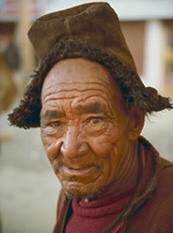The Dakpa (also known as the Sagtengpa or Brokpa) are one of the many tribal groups of Bhutan. It is possible that they are related to the Limbu of Nepal. They live in the eastern part of the country, mainly in the Sakteng Valley. They speak a language called Dakpakha. The Dakpa are often confused with the more numerous Brokpa partly because both groups are yak herders even though they speak different languages and have slightly different dress.
Most Dakpa are farmers. Their principal crops include corn, barley and beets. They work long hours in the fields in order to produce enough to feed their families. Other important activities include herding yaks and sheep and spinning and weaving wool. Most farmers also keep a few pigs and chickens. They use yaks as beasts of burden. Yaks also supply Dakpa families with meat and milk.
Since very little of the land in Bhutan is available for agriculture, the fields are often built in terraces up the mountain sides. Cultivation practices have changed little over the centuries, and most of the labor is provided by family members.
Dakpa women wear their hair long and dress in traditional styles. They typically wear red and white silk ponchos, red silk jackets decorated with animal designs, and red wool capes. They may also wear braided black wool jackets. The men wear leather or cloth pants under big, white wool trousers, red wool jackets, and sometimes sleeveless outer garments made of leather and felt. Both men and women wear turquoise earrings. The most distinctive part of the Dakpa outfit, however, is the unique felt hat. The hats are flat, felt discs made from yak hair. Each hat has five tail-like "spouts" that allow water to drain and the head to stay dry.
The Dakpa are virtually all Buddhist. They follow the "Yellow Hat" sect of Tibetan Buddhism. In addition, traditional Tibetan style shamanism is also practiced by some. The shamanists believe in an unseen world of gods, demons and ancestral spirits. They depend on a shaman (priest or priestess) to communicate with the spirits on their behalf.
Most Buddhist families have shrines for worship inside their homes. A poor family may have only a small Buddhist image or painting rather than a shrine. However, a wealthy family may use an entire room as a shrine, furnishing it with an elaborate altar, lamps, an incense burner, and other religious items.
Because of their history of isolation from other nations, the people of Bhutan do not trust outsiders. They are conservative by nature and value their ancient traditions. However, they are becoming more vulnerable to change due to their need for modern medicines and conveniences.
The Dakpa remain isolated and resistant to the gospel. Much prayer and evangelization efforts are needed to break down these walls of isolation and tradition, and to see the release of a missions force.
Pray that missions organizations and churches will accept the challenge of adopting and reaching the Dakpa.
Pray that the few Bhutanese and Nepali believers will rise to the challenge of taking the gospel to the Dakpa people.
Pray for the Lord to make a way for the Dakpa people to hear and respond to Jesus Christ.
begin breaking up the spiritual soil of Bhutan through worship and intercession.
Pray that churches that will plant other churches will be established among the Dakpa.
Scripture Prayers for the Dakpa in Bhutan.
https://people-groups.asiaharvest.org/India/Dakpa.pdf
| Profile Source: Joshua Project |











